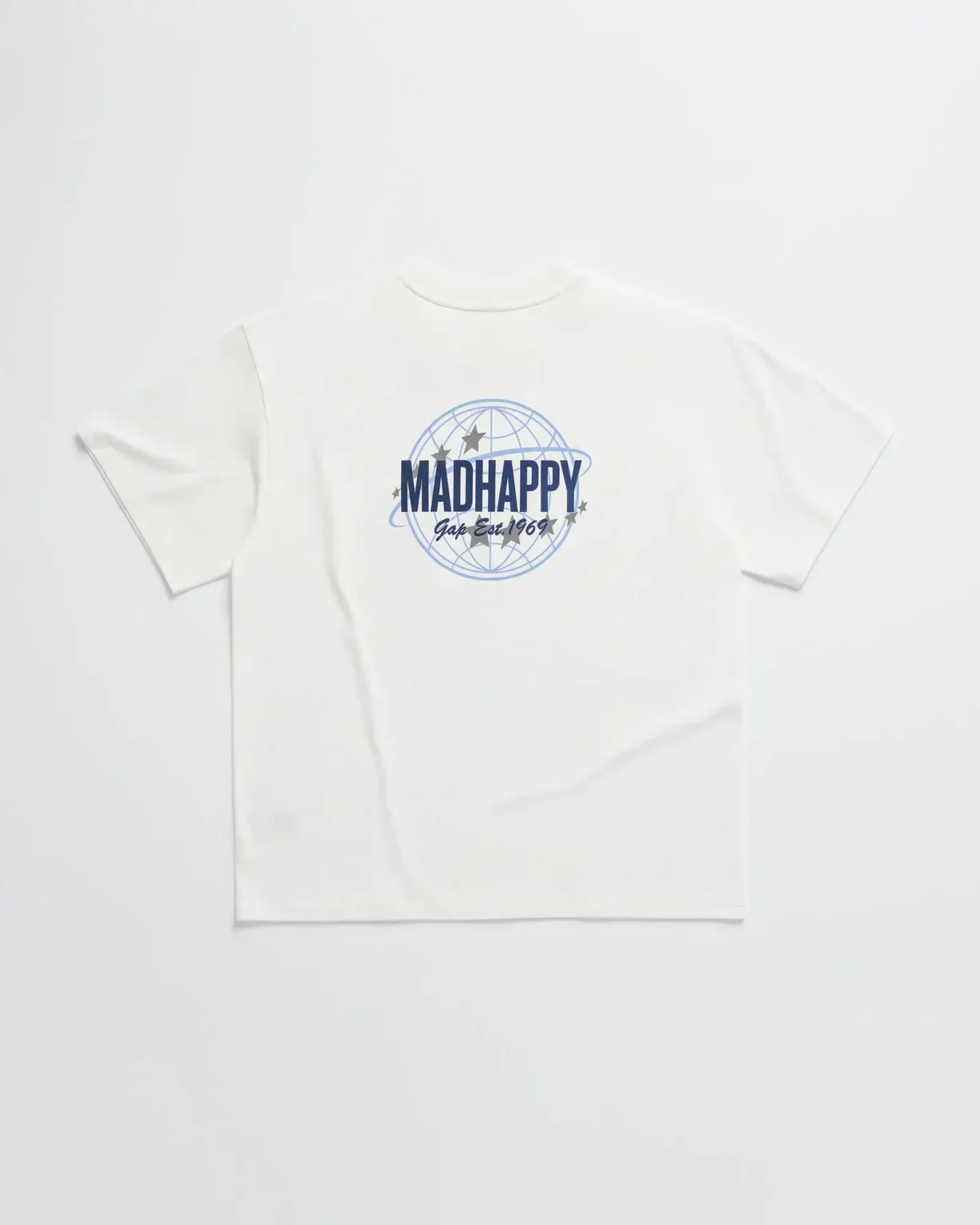Mad Happy: The Revolution of Positivity in Streetwear Culture

More Than Just a Clothing Brand
Mad Happy is not your average streetwear label. It’s a cultural movement, a mental health advocacy platform, and a beacon of hope for the modern generation wrapped up in premium cotton hoodies and pastel-colored joggers. In a world saturated with hype-driven brands, Mad Happy sets itself apart by embedding a genuine purpose into its design language—one centered around optimism and emotional wellbeing. Founded in 2017 by a group of young visionaries, the brand has quickly risen to prominence by marrying minimalist design with a maximalist mission: to make the world a more optimistic place. This essay will explore the birth, ethos, aesthetics, and impact of Mad Happy, dissecting how a clothing label has evolved into a global movement that resonates with millions.
The Origins of Mad Happy: Built on Emotion
Mad Happy was founded by Peiman Raf and his brother Noah Raf, alongside Mason Spector and Joshua Sitt. These founders were not just entrepreneurs—they were young adults who had personally battled mental health challenges and witnessed the pressures of modern life firsthand. The idea of Mad Happy was born out of a desire to start an open conversation about mental health, especially in an industry that often glorifies perfection and suppresses vulnerability. From the very beginning, the founders wanted to fuse fashion with purpose, art with advocacy, and comfort with consciousness.
Their approach was refreshingly honest. Rather than just designing clothes for profit, they wanted each garment to be a message—a symbol of hope, community, and support. That mission was embedded in the name itself. “Mad Happy” represents the juxtaposition of emotions that people often feel simultaneously: sadness and joy, anxiety and peace, struggle and triumph. In a sense, it’s a label for those who refuse to hide their complexity, who wear their emotions like they wear their clothes—with pride.
Aesthetic Identity: Where Color Meets Clarity
Mad Happy’s visual language is unlike any other brand in the streetwear space. Where most labels opt for moody blacks and edgy graphics, Mad Happy champions vibrant pastels, clean typography, and simple silhouettes. This design philosophy is both intentional and impactful. The color palette of baby blues, sunshine yellows, mint greens, and soft lavenders evokes calm and positivity, triggering emotional responses from those who wear the clothes and those who see them.
Every hoodie, sweatpant, and t-shirt is a canvas. The designs are often minimalistic, allowing space for bold messages like “Local Optimist” or “Mental Health Is Health” to stand out. This balance of aesthetic clarity and emotional depth makes each piece both fashionable and meaningful. It's no surprise that Mad Happy has become a go-to brand for Gen Z and Millennials who crave more than just clothing—they want to wear values.
The materials used also reflect the brand’s ethos. Premium French terry cotton, heavyweight fleece, and sustainable fabrics ensure that comfort and durability are prioritized. This aligns with the emotional experience Mad Happy aims to offer: wearing something that not only looks good but feels good too.
Mental Health: The Mission at the Core
What truly sets Madhappy Hoodie apart from every other fashion brand is its unwavering commitment to mental health awareness. This is not just a marketing strategy—it is the soul of the company. The brand created The Mad Happy Foundation, a nonprofit arm dedicated to improving mental health education, access, and research. A portion of proceeds from every product sold goes directly to mental health organizations, ensuring that each purchase has a purpose.
But Mad Happy doesn’t stop at donations. It uses its powerful platform to create real-world change. From panel discussions and blog content to collaborations with therapists and researchers, the brand actively engages in meaningful dialogue around mental wellbeing. Their podcast “The Mad Happy Podcast” features intimate conversations with public figures who discuss their own mental health journeys, creating space for vulnerability in a public forum.
Furthermore, Mad Happy's storytelling strategy is deeply emotional and human-centered. Campaigns feature real people sharing their experiences, not just models in studio lighting. These stories bring visibility to struggles that are often hidden and remind audiences that they are not alone.
Collaborations and Cultural Impact
Mad Happy’s growth has been exponential, partly due to its high-profile collaborations with brands like Lululemon, Columbia Sportswear, and the Los Angeles Lakers. These partnerships are not superficial—they are carefully crafted alliances that further the brand’s mission. For example, the Lululemon x Mad Happy collaboration was focused entirely on mindfulness and emotional wellbeing through movement. It featured limited-edition activewear designed to enhance both physical and mental health.
Similarly, the Mad Happy x Columbia drop redefined outdoor wear by making it stylish while promoting time in nature as a way to improve mental clarity. These collaborations not only boost visibility but also amplify Mad Happy’s message through new channels and audiences.
Celebrities and influencers such as Gigi Hadid, LeBron James, and Justin Bieber have been seen wearing Mad Happy, lending credibility and mainstream appeal. But despite its growing popularity, Mad Happy has never strayed from its original vision. It remains grounded, focused, and authentic—qualities that are rare in an industry driven by trends.
Community-Centered Experiences
Mad Happy’s retail experiences go beyond shopping—they are immersive, interactive, and intentional. Their pop-up shops across major cities like New York, Los Angeles, and Miami are designed as community spaces rather than mere storefronts. Visitors are often greeted with curated playlists, affirmational wall art, and free resources like journals and therapy guides. The goal is to create an environment that feels safe, welcoming, and uplifting.
These events often host mental health professionals and guest speakers, turning retail into a space for learning and healing. In a time when consumerism is often criticized for being shallow and exploitative, Mad Happy is redefining what it means to shop with purpose. Every element of the brand experience—from the physical to the digital—is designed to support emotional wellness.
The brand also leverages digital platforms to build community. Through Instagram, YouTube, newsletters, and their blog “The Local Optimist,” Mad Happy offers a steady stream of inspirational content, mental health tools, and community stories. This consistent engagement creates a sense of belonging that transcends the transactional relationship between brand and customer.
The Rise of Conscious Fashion
Mad Happy exists at the intersection of fashion and social change, representing a broader shift toward conscious consumerism. In an era where buyers are increasingly aware of how their money is spent, brands like Madhappy are becoming more desirable because they stand for something meaningful. The fashion industry, once criticized for being tone-deaf and exploitative, is slowly transforming thanks to players like Mad Happy who prioritize ethical production, sustainability, and mental wellbeing.
By weaving social values into the fabric of its operations, Mad Happy sets a new standard for what modern fashion can and should be. It’s not just about seasonal drops or celebrity endorsements—it’s about making a lasting impact in people’s lives. This conscious approach has sparked a ripple effect, inspiring both consumers and competitors to rethink the role of fashion in society.
Future Vision: Scaling Impact with Integrity
Looking ahead, Mad Happy shows no signs of slowing down. The brand continues to expand its reach while remaining laser-focused on its mission. Plans for global expansion, educational partnerships, and more accessible mental health resources are already in motion. However, the challenge now lies in maintaining authenticity while scaling—a delicate balance that many fast-growing brands fail to achieve.
The founders of Mad Happy have expressed a long-term vision that goes far beyond clothing. They aim to become a global mental health movement, one that influences education systems, corporate wellness programs, and public policy. If they continue to operate with the same integrity, transparency, and emotional intelligence, there is little doubt that Mad Happy will become one of the most influential cultural forces of our time.
Clothing With a Conscience
Mad Happy is a testament to the power of purpose-driven fashion. It proves that clothes can be more than just garments—they can be vehicles for change, conversation starters, and emotional lifelines. In blending design, community, and mental health advocacy, Mad Happy has carved out a unique and powerful space in both the fashion world and the cultural zeitgeist.
At its core, Mad Happy reminds us that it’s okay to feel everything, to wear our struggles, and to seek joy even in the darkest moments. It encourages us to find strength in vulnerability and connection in community. In a world that often feels overwhelming and fragmented, Mad Happy offers a simple yet profound message: optimism is a choice, and we’re all in this together. Through every hoodie, every campaign, and every conversation, Mad Happy is not just selling clothes—it’s selling hope. And that’s a revolution worth wearing.







